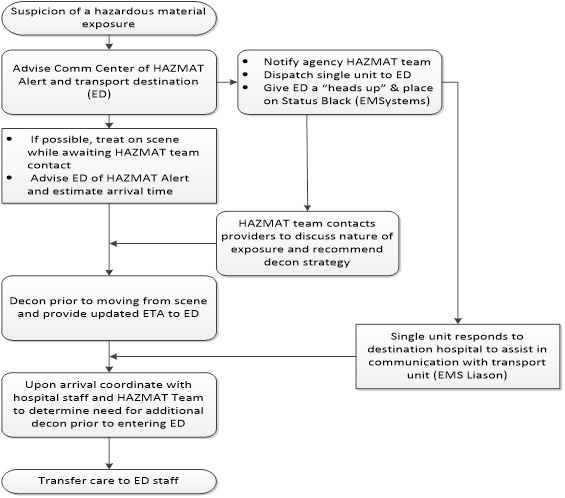Hazardous Materials: Difference between revisions
From Protocopedia
No edit summary |
No edit summary |
||
| Line 55: | Line 55: | ||
[[File:HazMatAlert. | [[File:HazMatAlert.jpg]] | ||
Revision as of 19:41, 11 July 2022
Section 5 -MEDICAL
5.08 HAZARDOUS MATERIALS
- It is imperative that the SAFETY of the civilian and emergency personnel be maintained while dealing with Hazardous Materials.
- PROTECT YOURSELF! Do not attempt to treat or remove the patient from exposure without appropriate personal protective equipment.
- Request response of Specialty Units / Haz-Mat Team.
- Maintain safe zone and assess scene from appropriate distance.
- Request information from Haz-Mat Incident Commander as to safety of approaching victims.
- After obtaining clearance from Haz-Mat Team and / or after the patient is decontaminated:
- While wearing heavy rubber gloves or two pair of regular exam gloves, remove ALL patient's clothing and place all materials, including the gloves, in a red biohazard bag.
- Irrigate patient with water.
- Advise Initial Receiving Facility of situation as soon as possible to facilitate early hospital preparations.
- INITIAL MEDICAL or TRAUMA CARE (2.01/2.02). Follow appropriate Practice Parameters for specific cases.
- Notify the Seminole County Communication Center that this is a HAZMAT ALERT, *this creates a standard method of patient care for incidents involving patients exposed to or suspected to have been exposed to a Hazardous Substance or Hazardous Material. By declaring a HAZMAT ALERT, a pre-planned series of events will take place to protect the patient, our personnel, and the receiving facility’s personnel. A HAZMAT ALERT will provide the following:
- Early notification to receiving hospitals of an incoming HAZMAT patient.
- Early involvement of the closest HAZMAT Team in decision making.
- Early involvement of Regional Poison Control or Medical Control.
- RESPONSIBILITY:
- All personnel assigned to Fire Operations and Communications.
- DEFINITION:
- A Hazardous Material is defined as any chemical compound found in solid, liquid or gas form that is not intended for human inhalation, ingestion or absorption.
- PROCEDURE:
- A HAZMAT ALERT should be initiated:
- At the time of dispatch, when a caller reports a medical emergency involving a chemical smell or hazardous material exposure.
- When the first arriving crew suspects a hazardous materials exposure due to odor, history or other sources of information.
- By Hospital Emergency Department staff in the event a hazardous material exposure is suspected, from a walk-in patient and additional resources are needed.
- Actions after a Hazardous Materials Exposure has been recognized:
- Immediately contact the Communications Center and initiate a HAZMAT ALERT.
- Advise the Communications Center of the EMS transport destination as soon as determined.
- Ensure all personnel are in appropriate PPE.
- After acknowledgement of a HAZMAT ALERT the Communications Center will:
- Dispatch the closest available Hazmat Team to the incident.
- Provide a “heads up” notification to the receiving facility by phone and also initiate a Hazmat Alert to the affected facility via EM System through Medcom.
- Notify the Regional Poison Control Center (1-800-222-1222) and advise them of the offending chemical, number of patients, and what facilitiy(ies)will be receiving the patient(s).
- If requested by the ED the Communications Center can place the receiving facility on Status Black until it is determined to be safe to resume normal EMS transports.
- If needed, assign units to a Command Channel in order to maintain uninterrupted communication between all parties involved.
- Once time permits, the Communications Center may arrange to have the Poison Control Representative make direct contact with someone on scene that has knowledge of the incident details. This will free up the dispatcher as well as help Poison Control ascertain information the dispatcher may not be able to provide.
- A HAZMAT ALERT should be initiated:
On scene units must make phone contact with Communications Center to confirm chemical involved
- Once notified of the HAZMAT ALERT, consult between on scene personal and the HazMat team shall occur to accomplish the following:
- Identify and research the hazardous material.
- Determine if Hazmat Team response is needed.
- Advise on scene crews of level of PPE required.
- Determine the nature of exposure and appropriate decontamination procedures.
- Advise on treatment in conjunction with Poison Control and local EMS protocols.
- Determine and advise when transport can be safely initiated for the patient and personnel.
- The hazmat team leader will make contact with the receiving facility and pass on all appropriate information about the patient, hazardous material involved, PPE and further decontamination procedures as necessary.
- Determine if a liaison is required to respond to the scene or receiving hospital to field questions between the ER staff and personal that may be extremely busy mitigating the scene and or patient care. The appropriate liaison may be a Chief Officer, Hazmat Team representative, or EMS Lt. History has shown the ER will want to make contact with an on-scene representative to ascertain information. Having a Liaison available will keep the communication loop open and improve the continuity of patient care
- Transfer of care:
- Prior to the ED arrival, transporting crews should contact the ED or FD liaison to convey pertinent information on the patient’s exposure, condition and the specifics of the decon strategy employed on the scene.
- Before entering the ED, allow the hospital staff to assess the need for further decon.
- General approach algorithm to a HAZMAT ALERT
- Once notified of the HAZMAT ALERT, consult between on scene personal and the HazMat team shall occur to accomplish the following:

